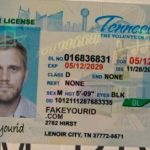In an age where identity theft and the creation of fake identification documents are growing concerns, the security features of ID cards have become of utmost importance. The year 2025 brings with it advancements in watermarks and anti – copying technology in ID cards, which play a crucial role in combating the issue of fake IDs.
## Watermarks in ID Cards
Watermarks have long been used as a security feature in various documents, and ID cards are no exception. A watermark is a faint image or pattern that is embedded in the card material during the manufacturing process. It is visible when the card is held up to the light.
### How Watermarks Work
Watermarks are created through a special papermaking or card – making process. In the case of ID cards made from paper – like materials, the watermark is formed by varying the thickness of the paper pulp during production. For plastic ID cards, the watermark is often incorporated using a technique that changes the refractive index of the plastic in a specific pattern.
When light passes through the ID card, the watermark becomes visible due to the difference in the way light is absorbed or transmitted through the areas with the watermark and the surrounding material. This makes it difficult for counterfeiters to replicate the watermark accurately, as it requires specialized equipment and knowledge of the manufacturing process.
### Types of Watermarks in ID Cards
– **Image – based Watermarks**: These are watermarks that depict a specific image, such as a national emblem, a portrait, or a symbol related to the issuing authority. For example, a national ID card might have a watermark of the country’s coat of arms. Image – based watermarks are not only a security feature but also a way to identify the authenticity of the card at a glance.
– **Text – based Watermarks**: These watermarks contain text, such as the name of the issuing country, the word “IDENTITY”, or other relevant information. Text – based watermarks can be used in combination with image – based watermarks to provide additional security and identification features.
## Anti – Copying Technology in ID Cards
Anti – copying technology in ID cards is designed to prevent unauthorized duplication of the card. With the widespread availability of high – quality scanners and printers, it has become easier for criminals to attempt to make fake IDs by copying legitimate ones. To counter this, various anti – copying measures have been developed.
### Holographic Elements
Holograms are a popular anti – copying feature in ID cards. A hologram is a three – dimensional image that is created using laser technology. When light is shone on a hologram, it appears to have depth and movement. In ID cards, holograms can be in the form of a small sticker or an embedded layer.
Holograms are difficult to replicate because they require precise laser equipment and a high level of technical expertise. The unique patterns and colors in a hologram make it a reliable indicator of an ID card’s authenticity. For example, a hologram on a driver’s license might display the license number in a three – dimensional format, along with a symbol of the issuing department.
### Microprinting
Microprinting involves printing very small text or patterns on the ID card. This text is often so small that it is difficult to read with the naked eye and requires a magnifying glass to be properly examined. Microprinting is a powerful anti – copying feature because it is extremely difficult to reproduce accurately when copying an ID card.
The microprinted text can contain important information such as the cardholder’s name, identification number, or a security code. If a counterfeiter tries to copy an ID card with microprinting, the microprinted elements will likely appear blurry or distorted, making it easy to detect the fake.
### UV – Reactive Inks
UV – reactive inks are another form of anti – copying technology. These inks are invisible under normal light but become visible when exposed to ultraviolet (UV) light. ID cards may have UV – reactive elements such as patterns, text, or images that are only visible when viewed under a UV lamp.
UV – reactive inks are difficult to replicate because the specific chemical composition of the inks is proprietary. Counterfeiters would need to have access to the exact same type of UV – reactive ink to accurately copy the ID card, which is not easy to obtain. For instance, a UV – reactive watermark or a security pattern on an ID card can provide an additional layer of security that is not immediately apparent to the casual observer.
## The Importance of These Technologies in Preventing Fake IDs
The combination of watermarks and anti – copying technology in ID cards is crucial for maintaining the integrity of identity documents. Fake IDs can be used for a variety of illegal activities, including underage drinking, identity theft, and fraud. By making it more difficult to create fake IDs, these security features help to protect individuals, businesses, and society as a whole.
For example, in the case of underage drinking, fake IDs are often used by minors to purchase alcohol. By having advanced watermarks and anti – copying technology in driver’s licenses and other forms of identification, retailers can more easily detect fake IDs and prevent underage access to alcohol. Similarly, in the financial sector, the use of secure ID cards with these features helps to prevent identity theft and fraud when customers are conducting transactions.
## Common Problems and Solutions
### Problem 1: Difficulty in Identifying Watermarks
– **Description**: Some people may have trouble seeing or recognizing watermarks on ID cards, especially if they are not familiar with the specific watermark design or if the card is damaged or dirty.
– **Solution**: Provide clear guidelines and training on how to identify watermarks. This can be in the form of brochures, online resources, or in – person training for those who handle ID cards, such as security personnel, retailers, and border control officers. Additionally, the design of watermarks can be made more user – friendly, for example, by using more distinct and easily recognizable images or text.
### Problem 2: Counterfeiters Finding Ways to Replicate Anti – Copying Features
– **Description**: As technology advances, counterfeiters may find new ways to replicate holograms, microprinting, or UV – reactive inks. They may also use sophisticated equipment to try and bypass the security features.
– **Solution**: Continuously invest in research and development to stay ahead of counterfeiting techniques. This can involve collaborating with security experts, scientists, and manufacturers to develop new and improved anti – copying technologies. Regularly update the design and composition of anti – copying features in ID cards to make it more difficult for counterfeiters to keep up.
### Problem 3: Compatibility Issues with ID – Reading Equipment
– **Description**: Some ID – reading devices may have trouble detecting or interpreting certain watermarks or anti – copying features, especially if the equipment is outdated or not properly calibrated.
– **Solution**: Ensure that ID – reading equipment is regularly updated and maintained. Provide technical support and training to operators of this equipment to help them troubleshoot any compatibility issues. Standardize the design and implementation of watermarks and anti – copying features to make them more easily detectable by a wide range of reading devices.
### Problem 4: False Positives in ID Verification
– **Description**: Sometimes, due to damage to the ID card, wear and tear, or interference from other materials, ID – verification systems may incorrectly flag a legitimate ID card as a fake.
– **Solution**: Develop more advanced ID – verification algorithms that can take into account factors such as card damage and environmental interference. Provide human – review options for cases where the system flags an ID card as a fake but there is a possibility of a false positive. Additionally, educate ID – verification personnel on how to handle such situations and make informed judgments.
### Problem 5: Public Awareness and Acceptance
– **Description**: The public may not be fully aware of the importance of watermarks and anti – copying technology in ID cards or may be skeptical about the security of these features.
– **Solution**: Launch public awareness campaigns to educate people about the role of watermarks and anti – copying technology in preventing fake IDs. Use various media channels, such as social media, print media, and public service announcements, to communicate the benefits and security aspects of these features. Address any concerns or misconceptions that the public may have to increase acceptance and trust in ID card security measures.
Fake ID Pricing
unit price: $109
| Order Quantity | Price Per Card |
|---|---|
| 2-3 | $89 |
| 4-9 | $69 |
| 10+ | $66 |


